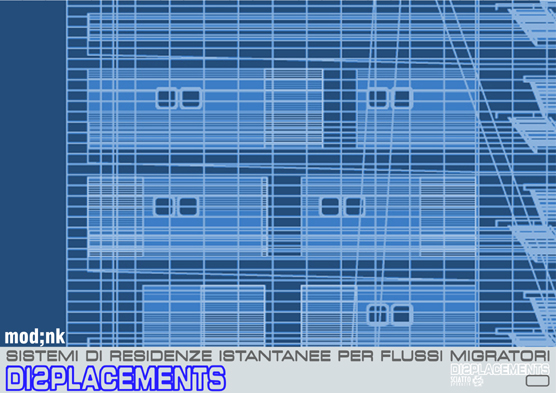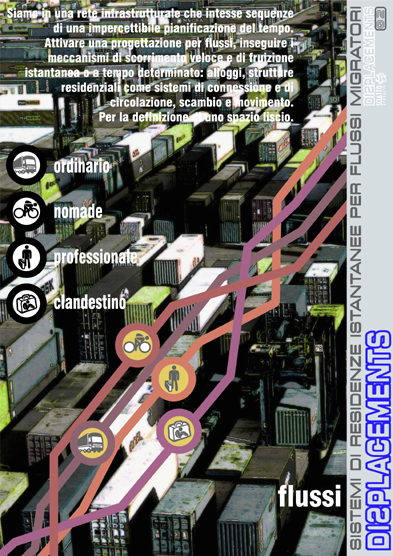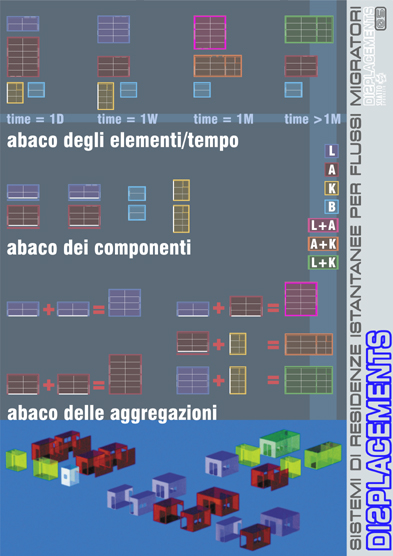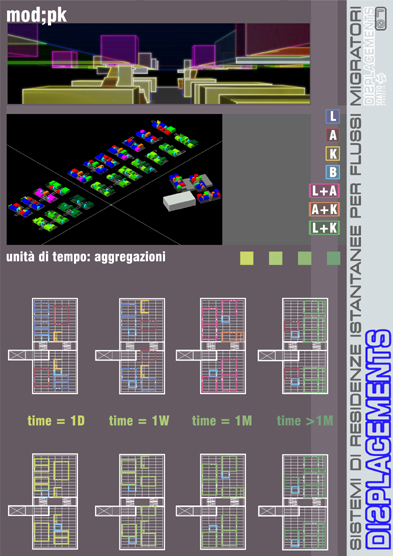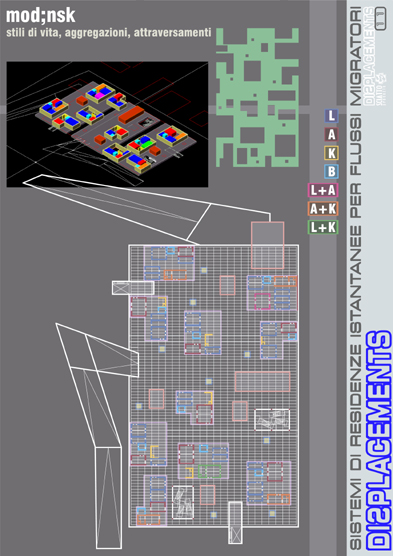Displacements
SCIATTO
(english | italiano)
Credits: DISPLACEMENTS , sistem of instant dwellings. Project: SCIATTO produzie - Francesca Iovino, Valerio Bindi, Cecilia De Biase. Collaboration: Karmen Franinovic, Bruno Iuricic, Marco Pompili. Instant dwellings Instant housing or temporary housing. Dwellings that are not only stages of passage, but that are capable of hosting, to welcome those who move speedly, who crosse and becomes part of the metropolitan flowing. A stream of displacements that is not simple movement of pleasure, but instead an energy, a plurality of crossings for which the stay becomes welcoming, interaction, sharing, narration.
Platforms First of all the location. The contemporary city in the sum of its textures, in the articulation of its flows, in the multiplicity of its activities and its users. This is the action ground, the platform in which to get into, on which be laid on, while pursuing the dynamics of territorial and infrastructural transforming. A project to be settled as a machine able to put into action different uses, to develop new socialities within daily spaces with multiple combinations. The opportunity to build spatial alterations, because it's a question of architectonic systems superimposed to the compact city, residential devices that interact with the urban tissue, that assimilate the evolvement and movement logics. They are frameworks that modify the urban landscape, while preserving and incorporat the free areas, the ones without any programming, those places considered as unreality fields, or better accessible limits with subsequent transformations not related to with rough or uncertain planning. Trajectories The urban structure takes form then as complex device: buildings and paths' system together become architectural emergencies, dimensional and gathering elements of the constructed space. The directrices of concentration and mutation are fixed as tracks on the ground, as "tapes" of connection and most of all, as arteries of link, interrelation, transit. The trajectories of traffic, the plots of any possible transfer outline a frame of continuous junctions and returnings, in which the distances become links of approach rather than separations and the crossing takes prominence as ratio of place's change rather than as overcoming of intervals. Whereas the break doesn't mark a gap or an interruption anymore, but a simple joint among following stops. An infrastructural net that interweaves sequences of an imperceptible time planification, just not only an ordinate and constructed plot as Paul Virilio suggests inside his article "The overexposed city". To attempt then a planning by flows, by chasing the mechanisms of speed sliding and instant or fixed time using: dwellings, residential structures that take form as system of connection and current, exchange and movement. Stops The habitation is thus shelter and traffic zone, stages' passage or departure's knot, but certainly it's unique microcosm of the built web. Because the housing settles as action of motion, rite of transition, condition for interacting. In each place, in each town, finding the opportunity to recognize a reference space inside the net of the seeming displacements, a space as right stop: a temporary, household dwelling, able to change during the transit and able to mutate, to suit, to conform within the stay. They are provisional houses, Woongroep never fixed or final, gathering of "private zones" and common spaces. Dwelling dispensers, residential moduli with checked cost for a day, a week, a month. The bed is dimensional unit, the dwelling is a combination of bed-unit, the housing space is sum of habitations and common zones. That is, hybrid spaces, collective identifiable areas and connective tissue with free fruition. Proportional combination between using spaces and times for an environment that has to be habitual also within its own transitory and temporary use. Devices In the complexity of the metropolitan frame, concentration of compact mechanisms, of building that is fabric and infrastructural net and empty or missing or still, residual places, emerges the potentiality to insert a housing device, that is assembling of interrelated and separated levels. It's not a question of mechanism that fixes a single destination, instead it's an architetctonic device that requires additional values, that is characterized in the peculiarity of its territorial arrangement, of its urban image, but most of all in the quality of the services and the integrated values. The new lifestyles mix activities, identities, times, connections: the housing becomes dynamic structure, "horizontal composition" of complex and different places. From the atelier-houses, to the habitations for groups of singles or of familiar nuclei, to dwellings for who is prefarably permanent or for who moves and transit within limited times. From hybrid spaces with multiple use, to specific areas for fixed service: a plurality of destinations that combine different individualities and cultures, by constructing temporary and permanent microcommunities, "border places", joints of intermetropolitan connection. Technologies of industrial production for machines, for scaffoldings with harbour use as bearing structures, mechanisms able to support big loads and at the same time to show an immediate architectural distinction: instant houses as crossing dwellings, as surfing zones in the metropolitan territory. Architectonic devices against social apartheid for a horizontal consumption of the city, for the definition of urban and transurban microstories subtracted to the scanning of the global time. Francesca Iovino/SCIATTO produzie
|
|
